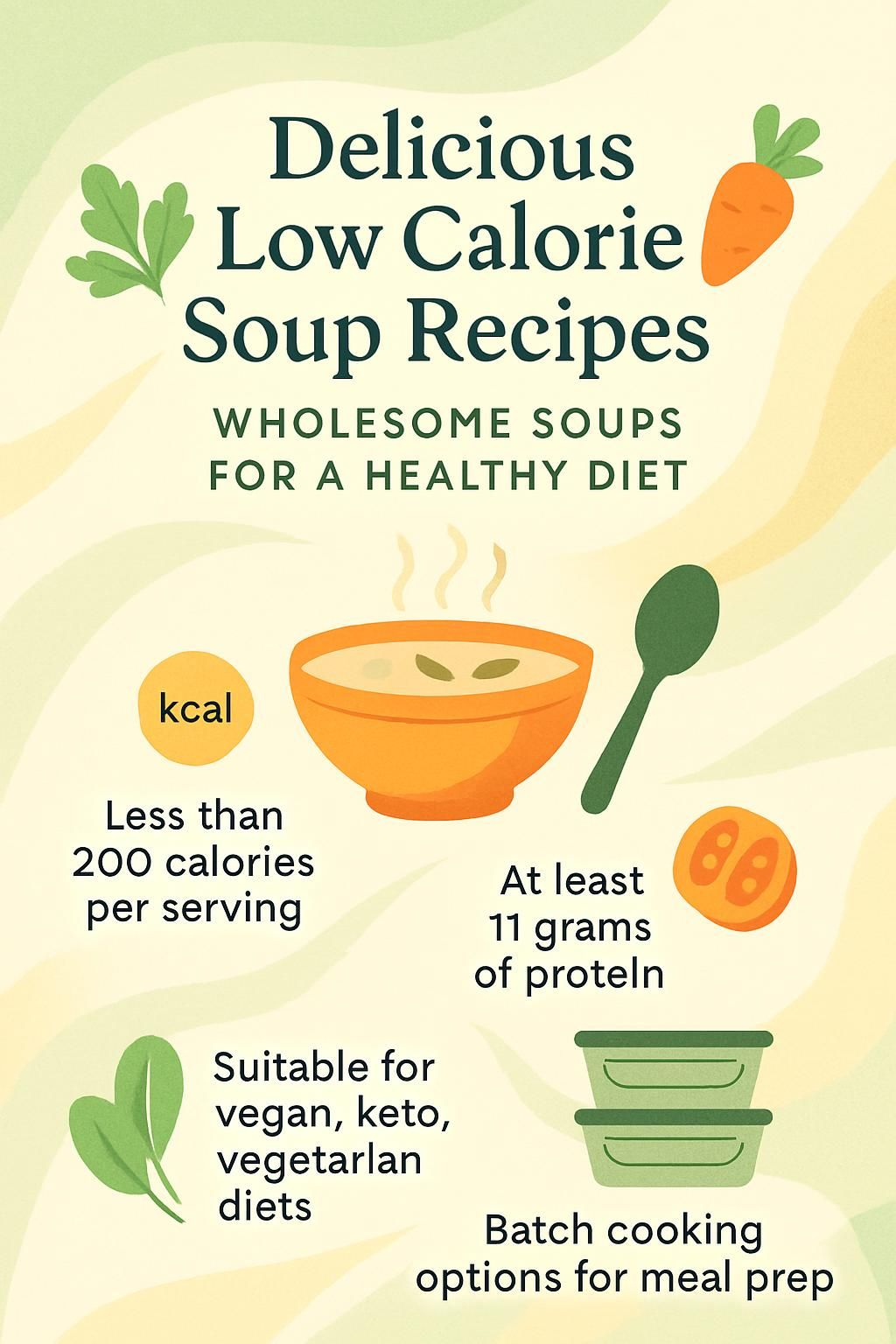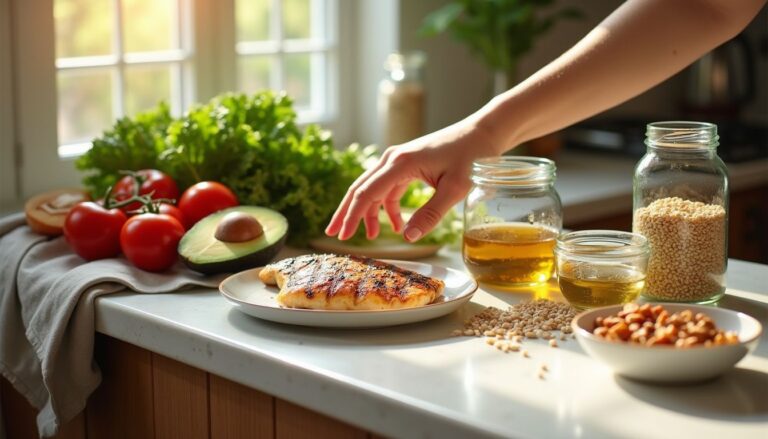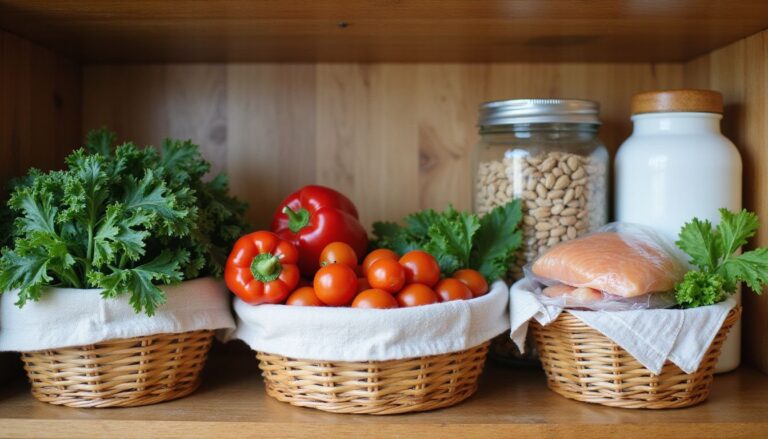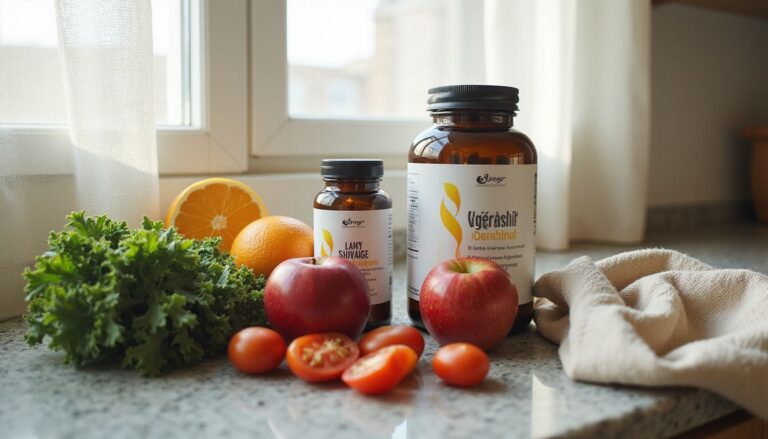Delicious Low Calorie Soup Recipes: Wholesome Soups For A Healthy Diet
Our Nutrition Assistant AI Suite will transform your body. You will lose fat, get toned, and build muscle. Gain confidence and optimal health.
If you are trying to manage weight without sacrificing flavor, low-calorie soup can help. Most bowls land under 200 calories per serving and include at least 11 grams of protein to keep you satisfied.
This guide shares simple soup recipes, smart nutrition tips, and affordable ideas for meal prep. You will find easy wins for busy nights and comforting flavors in every bowl.
Key Takeaways
- Many low-calorie soup recipes here stay under 200 calories per serving and deliver 11 grams of protein or more to improve fullness.
- Lean proteins like chicken, turkey, lentils, and beans pair with high-fiber vegetables such as cabbage and spinach to support weight control.
- Swap heavy cream for pureed vegetables or 1 percent milk to reduce saturated fat. Herbs and spices add big flavor with almost no calories.
- Batch-friendly options, including cabbage barley soup and chicken vegetable soup, make weekly meal prep simple and budget friendly.
- Recipes can be adapted for vegan, vegetarian, or keto needs. Using low-sodium broth and lean meats supports heart health.

Nutritional and Lifestyle Benefits of Low-Calorie Soups

Low-calorie soups combine protein and fiber to help you feel full with fewer calories. These wholesome bowls fit a plant-based diet, support hydration, and align with most wellness goals.
What are the key nutritional benefits of low-calorie soups?
Low-calorie soups give you nutrients without lots of fat or added sugar. Vegetables such as spinach, cabbage, tomatoes, and carrots bring vitamins, minerals, and dietary fiber.
Adding lean meats, lentils, or beans can lift each serving to at least 11 grams of protein. Higher protein helps you stay satisfied and may steady blood sugar. Using chicken broth and 1 percent milk instead of heavy cream lowers saturated fat while keeping flavor.
Choosing low-sodium broth supports heart health. Many broth-based soups also fit diabetic meal planning. Vegan versions work with simple swaps like vegetable broth and plant-based milk.
In my kitchen, hearty bowls loaded with legumes and whole grains leave my family energized. Health organizations, including the Academy of Nutrition and Dietetics, encourage higher fiber and lean protein for satiety and weight control.
How do low-calorie soups support weight management?
Low-calorie soups help you feel full with fewer calories. A broth-based vegetable soup often falls under 200 calories per serving but keeps hunger away for hours.
Fiber from beans and lentils slows digestion and improves satiety. Many recipes here provide at least 11 grams of protein per serving, which supports fullness and muscle maintenance during calorie restriction.
Lean meats such as chicken breast and turkey add quality protein with less fat. Chicken tortilla soup can deliver about 200 calories in 1.25 cups, which makes portion control easier.
Vegetables and broth add volume, so your meal has a lower calorie density. I noticed that eating cabbage barley soup, about 197 calories per 1.5 cups, before dinner helped me eat less of rich foods later.
High-fiber and high-protein soups can increase satiety leading to reduced total calorie intake, says a registered dietitian from the Academy of Nutrition and Dietetics.
Cooking a large pot once, such as cabbage soup or chicken soup, gives you quick meals all week. Stored in the refrigerator, a filling bowl is ready any time cravings spike. This habit helped me lose weight at a steady pace without feeling deprived.
Why do low-calorie soups offer versatility and variety?
Low-calorie soups welcome many ingredients, from zucchini and carrots to turkey or lentils. You can tailor them for vegan or vegetarian needs with simple swaps.
Frozen vegetables, canned tomatoes, beans, and chicken make meal prep fast and affordable. Global flavors fit easily, including Thai shrimp soup, pepper soup with Moroccan spices, classic chicken noodle soup, butternut squash soup, and creamy cauliflower soup.
Pick your method, including slow cooker, Instant Pot, or stovetop. Customize with toppings like avocado or tortilla strips. I often swap items based on what is already in my pantry.
For a family gathering, I used one vegetable broth base and created both beef soup and split pea soup that tasted completely different. Some recipes feed two, others feed twenty-six, so there is an option for any group size.
How to Make Low-Calorie Soups That Taste Great
A great pot of soup can be light, flavorful, and deeply satisfying. A few smart steps turn simple ingredients into comfort food that supports your healthy diet.
Why use fresh, whole ingredients in low-calorie soups?
Fresh, whole ingredients such as spinach, butternut squash, lean chicken, and dried lentils improve taste and nutrition. Minimally processed foods deliver more vitamins, minerals, and fiber than packaged items high in preservatives.
Vegetables like cauliflower, celery, and cabbage add nutrients with very few calories. Lean turkey and chicken keep fat lower. Fresh herbs such as dill and parsley provide big flavor.
Frozen vegetables and canned tomatoes are convenient and still nutritious for busy days. My homemade tomato soup with fresh basil tastes brighter than most store options.
Fresh ingredients make soups that satisfy and help you stay full longer.
Soup is packed with flavor when you use real, whole foods—one soup pot can transform your healthy meals.
How can I avoid heavy creams and fats in soups?
Choosing fresh ingredients improves flavor and nutrition. You can still enjoy a creamy texture while keeping calories low.
Use broth or 1 percent milk in place of cream. For example, Cream of Cauliflower Soup can deliver about 186 calories and 11 grams of fat per cup. Pureed vegetables such as cauliflower, potatoes, or pumpkin give a silky feel without heavy cream.
Egg ribbons, as used in hot and sour soup, add body with minimal fat. A small swirl of yogurt works better as a garnish, not the base. Lean proteins like chicken or plant-based sausage bring flavor with fewer calories, useful in keto chicken soup or sausage and spinach tortellini soup.
Spinach, zucchini, Swiss chard, and mushrooms improve texture with little fat. Pureed beans or lentils also build richness while keeping calories in check.
What are the best high-fiber vegetables to add to soups?
High-fiber vegetables make soup more filling without many calories. They add vitamins, minerals, and texture to lentil soup, bean soup, or potato soup.
- Cabbage offers about 3 grams of fiber per 1.5 cups and shines in cabbage barley soup and vegetable stews.
- Lentils bring a hearty bite. They supply meaningful fiber in spiced soups and turkey sausage lentil soup.
- Navy beans are rich in fiber and lift both flavor and texture in navy bean soup or ham and lentil soup.
- Tomatoes add body and antioxidants to Instant Pot lentil soup and many vegetable soups.
- Carrots and celery are classic soup builders that add fiber and balance to chicken vegetable soup and light chowders.
- Butternut squash provides fiber and natural sweetness. It brightens creamy soups and turkey squash soup.
- Spinach blends easily into keto chicken soup or tortellini soup, adding fiber with very few calories.
- Peppers add color, flavor, and fiber in slow-cooker stuffed pepper soup and vegetable beef soup.
- Onions appear in almost every soup and bring subtle sweetness and savory depth.
- Black beans pair well with cumin, chili pepper, and coriander for Mexican-style black bean soup.
When I tested cabbage barley soup and spicy lentil soup, the added fiber clearly increased fullness. Mix several of these vegetables in your next Instant Pot soup for a satisfying result.
How do herbs and spices enhance soup flavor without calories?
Herbs and spices boost flavor without adding calories, sugar, or fat. Fresh dill and lemon juice brighten Dill Chicken Soup at about 198 calories per cup.
Cumin, chili powder, and enchilada sauce add savory depth to Chicken Enchilada Soup while staying light. Garlic, red pepper, and Italian herbs turn Sausage and Spinach Tortellini Soup into a fragrant meal without cream or butter.
Rice vinegar and a small amount of sesame oil give hot and sour soup a bold profile. Curry powder, ginger, and fresh herbs power Thai shrimp soup at only 163 calories per serving. Cilantro, green onions, and parsley add pops of flavor and color at the end.
A shake of black pepper or a bay leaf can add gentle depth. I like finishing asparagus soup with thyme and a little lime for layered taste.
High-fiber vegetables and bold seasonings help you skip cheese or butter while keeping flavor high.
Delicious Low-Calorie Soup Recipes to Try
These recipes use whole ingredients, lean protein, and fiber-rich vegetables. Each one supports a balanced diet while keeping calories in check.
How to make classic chicken and vegetable soup?
Classic chicken and vegetable soup fits large families or potlucks. It serves 16 and makes about 4 quarts, so it works well for meal prep.
- Choose lean chicken breast, or use leftover rotisserie chicken to save time and reduce fat.
- Chop carrots, celery, onions, and add spinach or split peas for extra fiber.
- Fill a large stockpot with water, then add all ingredients and bouillon cubes for flavor with little fat.
- Season with salt, black pepper, turmeric, clove, and parsley. Spices increase flavor with almost no calories.
- Bring to a boil, then reduce to a gentle simmer so flavors blend and the chicken stays tender.
- Add frozen vegetables during the last 15 minutes for color and nutrients. Leftover rice or tortellini adds variety.
- Thicken lightly with a flour-water slurry if you prefer a heartier texture. Use small amounts.
- Simmer for at least two hours so vegetables, mushrooms, and herbs develop full flavor.
- Top with grated Parmesan or nutritional yeast instead of cheddar to keep it lighter.
- Store leftovers in airtight containers. It freezes well and reheats quickly on busy days.
I once made this after Thanksgiving using leftover turkey. It was hearty and satisfying without feeling heavy.
What is a creamy cauliflower soup without cream?
Creamy cauliflower soup can be velvety without heavy cream. Smart swaps keep calories and fat down while holding rich flavor.
- Use chicken broth and 1 percent milk instead of cream for a silky base.
- Let cauliflower act as the thickener to create a creamy mouthfeel with less dairy.
- One serving lands near 186 calories, with about 11 grams of fat and 13 grams of protein.
- Stir in a small amount of sharp or smoked cheddar for extra flavor if you wish, then adjust calories as needed.
- Make it in about 20 minutes, which suits weeknight dinners or last-minute guests.
- For a vegan version, choose plant-based milk and broth. Cauliflower still delivers creaminess.
- Created by Debbie Ohlhausen of Chilliwack, BC, the recipe serves up to six people.
- I blend steamed cauliflower with low-fat broth in a blender at home. The texture turns smooth without cream.
- Finish with parsley or chives for extra flavor without extra calories.
Next, try a spicier option that brings heat and protein.
How do you prepare spicy lentil soup?
Spicy lentil soup is hearty, affordable, and simple to cook. It offers fiber and protein while staying light.
- Gather dry lentils, diced tomatoes, onions, celery, carrots, garlic, and optional spinach. Use chicken breast or plant protein for more protein.
- Warm a large pot over medium heat. Sauté onions, carrots, celery, and garlic until soft.
- Stir in ground cumin, chili powder, red pepper flakes, or hot paprika for heat and depth.
- Add rinsed lentils and diced tomatoes. Pour in 6 to 8 cups of water or low-sodium vegetable broth.
- Simmer for 35 to 40 minutes until lentils are tender. Stir in cooked diced chicken for extra protein like in a spiced-up healthy soup at about 156 calories per cup.
- Taste and season with salt and black pepper. Add more chili powder for extra heat, or squeeze in lime.
- Garnish with parsley or cilantro to add brightness without extra calories.
- Serve hot with a lemon wedge or a small spoon of Greek yogurt. Each cup can provide around 11 grams of protein with only about 3 grams of fat.
- Store leftovers in airtight containers. The flavor deepens by the next day.
- Use plant-based sausage or gluten-free noodles if you need a meatless or gluten-free option.
Spices inspired by Moroccan cuisine give this soup warmth while supporting weight goals through high fiber.
What are the steps for butternut squash and turkey soup?
Butternut squash and turkey soup brings comfort, protein, and balanced nutrition. It is simple to make and easy to customize.
- Sauté cubed butternut squash with chopped shallots or onions in a large pot using a small amount of oil for about 5 minutes.
- Add 3 to 4 cups of low-sodium chicken broth. Bring to a simmer over medium heat.
- Stir in 1 to 2 cups of shredded or diced cooked turkey breast for lean protein.
- Mix in baby spinach to boost fiber and micronutrients. Cook 2 to 3 minutes until wilted.
- Season with cracked black pepper, dried thyme, parsley flakes, and a splash of lime juice.
- Adjust seasoning to taste. Skip cream, since squash naturally adds creamy texture.
- Serve about 1 and 1/3 cups per person. A serving is roughly 192 calories, about 2 grams fat, 25 grams protein, and 60 milligrams cholesterol.
- Swap sweet potatoes for squash if you prefer, both work well with lean turkey.
- Add a few crushed tortilla chips on top for a turkey tortilla soup twist.
- Refrigerate leftovers and reheat gently. This soup also freezes well.
I make this every winter with leftover holiday turkey. The creamy texture from the squash always wins at my table while keeping things light.
How to make cabbage barley soup?
Cabbage barley soup is a high-fiber, low-calorie choice that is great for batch cooking. This slow-cooker version serves eight.
- Chop one medium head of cabbage, two carrots, two celery stalks, and one onion. Choose affordable vegetables for value and nutrition.
- Rinse 3/4 cup pearl barley. Barley adds fiber and a chewy texture.
- Pour 32 ounces of V8 juice into your slow cooker, then add the vegetables and barley.
- Stir in 5 cups of low-sodium vegetable broth to enhance flavor while limiting sodium.
- Season with 2 teaspoons Italian herbs, 1 teaspoon black pepper, and a pinch of salt. Keep it lean by avoiding cream.
- Mix well and set the slow cooker on low for 6 hours and 30 minutes.
- Check that vegetables are tender and barley is soft but not mushy.
- This recipe yields about 3 quarts. A 1.5-cup serving contains about 197 calories, roughly 1 gram fat, and about 11 grams protein.
- For a vegetarian version, use plant-based broth. Swap in another familiar grain if you do not like barley.
- Freeze leftovers for up to three months. It is a helpful make-ahead meal for busy weeks.
- Serve alongside a whole-grain dumpling or a small spinach soup for variety without many extra calories.
What is the recipe for Thai shrimp soup?
Thai shrimp soup packs fresh flavor with protein-rich shrimp and fragrant curry. Each serving falls under 200 calories.
- Gather peeled, deveined shrimp, curry powder, chicken broth, lime juice, and fresh herbs. Add mushrooms or other vegetables if desired.
- Sauté onions and garlic in a large pot with a small amount of oil to build flavor.
- Stir in curry powder briefly to release aroma without adding calories.
- Pour in 2 quarts of chicken broth and bring to a simmer. Add mushrooms or bell peppers.
- Cook shrimp until pink, about 2 to 3 minutes. Do not overcook.
- Stir in fish sauce, lime juice, and chopped cilantro or basil before serving.
- Serve 1 cup per person. Each serving is about 163 calories, 7 grams fat, 14 grams protein, 69 milligrams cholesterol, 505 milligrams sodium, and 9 grams carbs with about 2 grams fiber.
- The recipe makes about eight servings, or roughly two quarts. Double it for guests or freeze portions for later.
- Diabetic exchanges: 2 lean meat, 1 vegetable, 1 fat per serving, based on analysis by Jessie Grearson, Falmouth, ME.
- I added extra lime to my batch. The broth tasted brighter while staying light.
- Toss in spinach at the end, or add a soft-cooked egg as a topping for extra protein.
Home cooks often praise this soup for big flavor and a healthy profile that fits many eating plans.
How to cook hot and sour soup?
Hot and sour soup delivers bold flavor with a modest calorie count. You can prepare it in about 35 minutes using common ingredients.
- Gather eggs, rice vinegar, sesame oil, broth, tofu or lean meat, mushrooms, bamboo shoots, soy sauce, white pepper, scallions, and optional chili.
- Bring broth to a gentle simmer in a large pot. Use chicken or vegetable broth.
- Add sliced mushrooms and bamboo shoots. Cook for about 5 minutes.
- Mix in soy sauce, rice vinegar, and a small splash of sesame oil for classic flavor.
- Whisk eggs, then drizzle slowly into the simmering broth while stirring to create silky ribbons.
- Add tofu for extra protein, or swap in lean meat if preferred. Stir gently after adding the eggs.
- Season with white pepper, scallions, and optional chili flakes. Keep sodium reasonable by tasting before salting.
- Divide into four bowls. Each serving has about 149 calories, 8 grams fat with 2 grams saturated, 13 grams protein, 93 milligrams cholesterol, 1602 milligrams sodium, and 8 grams carbs with about 1 gram fiber.
- Use vegetable broth and omit meat for a vegetarian version. The soup stays hearty and flavorful.
This method gives you a satisfying bowl that is strong on taste and light on calories.
What ingredients go into vegetable beef soup?
Vegetable beef soup brings together lean protein, vegetables, and savory broth. Sue Straughan of Prattville, Alabama, created a version that serves 26 and freezes well.
- Choose 90 percent lean ground beef to keep fat lower. A serving delivers about 18 grams of protein with about 6 grams of fat.
- Add diced potatoes for substance and fiber.
- Include carrots, celery, onions, and bell peppers for vitamins and natural sweetness.
- Use peas, corn, green beans, and tomatoes for color, fiber, and variety in every spoonful.
- Pour in low-sodium beef broth to manage salt, around 1090 milligrams per serving.
- Season with garlic or garlic powder, black pepper, and dried thyme or basil for flavor without calories.
- Stir in barley for texture and extra fiber. It helps you stay full longer.
- Cook slowly for at least four hours so flavors blend and beef turns tender.
- Use tomato paste or extra diced tomatoes to thicken the broth instead of flour or cream.
- Freeze leftovers in airtight containers. The soup reheats well on busy days.
Next, use these steps to adapt soups while keeping carbs or calories in range.
How to make keto-friendly chicken soup?
Keto chicken soup takes about 35 minutes and uses simple ingredients. Each cup provides about 199 calories and 22 grams of protein.
- Dice chicken breast into bite-size pieces for quick cooking.
- Sauté onions and garlic in a small amount of olive oil for flavor.
- Pour in low-sodium chicken broth to keep sodium reasonable. One serving is about 861 milligrams sodium.
- Add low-carb, high-fiber vegetables such as spinach. Carbs stay near 5 grams per serving.
- Simmer until chicken is cooked through, about 15 minutes.
- Season with thyme, parsley, or oregano to boost flavor without extra calories.
- Taste and adjust salt or pepper.
- Serve hot. Each cup has about 10 grams of fat with 2 grams saturated.
- Customize with broccoli or zucchini based on your taste.
- I make this for lunch meal prep. It keeps me energized through the afternoon with few carbs.
- Recipe by Dan Roberts from Taste of Home yields six servings.
What is the recipe for turkey meatball soup?
Turkey meatball soup offers a balanced, lighter meal. This Meatball Alphabet Soup serves nine and pleases both kids and adults.
- Use lean ground turkey for lower fat meatballs.
- Add alphabet pasta for fun and kid-friendly appeal.
- Season the turkey with herbs before forming small meatballs to lock in flavor.
- Use carrots and celery to add fiber and key nutrients.
- Simmer meatballs in low-sodium chicken broth until cooked through.
- Add tomatoes or tomato paste for richness while keeping it near 192 calories per 1.5-cup serving.
- Cook pasta until just tender so it does not turn mushy. A serving includes about 26 grams of carbs.
- Skim any visible fat as the soup simmers. Saturated fat stays about 1 gram per serving.
- Cool, then refrigerate or freeze in portions for easy reheat meals.
- Total time is about 55 minutes according to Taste of Home test standards.
My family enjoys this after sports practice because it provides protein, about 13 grams per serving, without feeling heavy.
Creative Ways to Boost Low-Calorie Soups
Simple add-ins can raise nutrition and flavor while keeping calories modest. Try these upgrades to make every bowl count.
How does zucchini puree add creaminess without calories?
Zucchini puree blends into soups to create creaminess with very few calories. It can stand in for heavy cream in recipes like creamy cauliflower soup.
It adds fiber and micronutrients without extra fat. Blended zucchini mixes smoothly into broth-based soups, which suits vegan and dairy-free cooking.
Its mild flavor works with many ingredients. It thickens soup without raising carbs. One cup of chopped zucchini has about 20 calories, so it is a smart choice when you want volume without added fat.
What protein-rich ingredients like lentils or beans work well?
Lentils and beans are easy ways to raise protein in low-calorie soup. Try different types to change flavor and texture.
- Lentils bring a mild, earthy taste and a protein boost. Instant Pot lentil soup often delivers around 12 grams of protein per cup. A spiced lentil soup can reach about 11 grams per cup.
- Navy beans can provide around 18 grams of protein per cup in navy bean soup. They also thicken soup naturally.
- Ham or turkey sausage with lentils adds variety. A ham and lentil soup can reach about 14 grams of protein per cup. A turkey sausage lentil soup can deliver around 15 grams of protein in 1.25 cups.
- Chickpeas or black beans fit vegetable broths and support satiety for steady energy.
- Tofu or plant-based sausage keeps vegetarian soup higher in protein.
These ingredients kept my workday lunches filling with little extra prep. Next, consider light grains and noodles for more substance without too many calories.
Which low-calorie noodles or grains can I add?
Choose grains and noodles that add fiber and texture without pushing calories too high. Small portions can make soup feel more complete.
- Barley is a great choice in cabbage barley soup, about 197 calories per 1.5 cups, and brings chew.
- Brown rice fills out stuffed pepper soup. A 1.5-cup portion can land near 141 calories.
- Alphabet pasta keeps Meatball Alphabet Soup fun and light, about 192 calories for 1.5 cups.
- Egg noodles fit matzo ball soup, and you can swap noodles for matzo balls if you want fewer carbs.
- Ramen cooks quickly for shrimp ramen, around 148 calories per cup, which is handy on weeknights.
- Quinoa adds extra protein and fiber. It gives veggie soups a pleasant bite.
- Whole-wheat pasta offers more nutrients than white pasta with similar calories.
- Tortellini adds richness in chicken tortellini and sausage spinach tortellini soup. Use a smaller portion since it can reach 354 calories per 1.75 cups.
With these options ready, you can dial in your preferred texture and fullness.
Low-Calorie Soups Under 200 Calories You Can Make
Each soup here stays under 200 calories per serving. You still get satisfying portions, rich flavor, and simple preparation.
How to prepare shrimp ramen under 200 calories?
Shrimp ramen is quick, light, and tasty. It cooks in about 15 minutes and keeps calories low.
- Gather peeled shrimp, low-sodium chicken broth, quick-cooking ramen, and vegetables.
- Bring four cups of broth to a boil in a large pot over medium-high heat.
- Add eight ounces of shrimp and vegetables such as carrots or spinach for fiber.
- Break the ramen noodles into smaller pieces and add to the pot.
- Season with low-sodium soy sauce, minced garlic, and fresh ginger. Skip heavy oils.
- Cook until shrimp turns pink and noodles soften, about five minutes.
- Taste and adjust with herbs or lemon juice instead of more salt.
- Divide into four servings. Each cup provides about 12 grams protein, 4 grams fat with 2 grams saturated, and 17 grams carbs.
- Finish with chopped green onions or cilantro for more flavor without many calories.
- Refrigerate leftovers in an airtight container for a quick lunch later.
I first made this after seeing Donna Hellinger’s version from Lorain, Ohio. It kept me full all afternoon without sluggishness.
What is an easy recipe for beef barley soup under 200 calories?
Beef barley soup can feel hearty yet stay light. Lean beef and pearl barley create a filling bowl under 200 calories per cup.
- Start with one pound of lean beef stew meat, inspired by Elizabeth Kendall’s recipe from Carolina Beach, North Carolina.
- Brown the beef in a large pot with minimal oil to build flavor while limiting saturated fat.
- Add onions, carrots, and celery for fiber and nutrients.
- Pour in low-sodium beef broth, about eight cups, to reduce salt.
- Stir in 2/3 cup pearl barley. It delivers texture at about 10 grams of carbs per serving.
- Season with garlic, pepper, thyme, and bay leaf instead of salt-heavy mixes.
- Simmer for about two hours so the beef softens and flavors deepen.
- Serve 1-cup portions. Each serving is about 133 calories, 4 grams fat with 1 gram saturated, 14 grams protein, and 28 milligrams cholesterol.
- The recipe yields nine servings or about 2.25 quarts. Freeze extras for later.
- I cook this on Sundays. It reheats well and keeps a pleasant texture all week.
This process gives you a satisfying bowl that supports healthy eating targets.
How to make navy bean soup with fewer than 200 calories?
Navy bean soup can be hearty and still stay under 200 calories per serving. Use this lighter method while keeping flavor.
- Start with one pound of dried navy beans. They are high in fiber and budget friendly. Soak overnight for a softer texture and faster cook time.
- Use water or low-sodium vegetable broth as your base. Skip cream, butter, and excess oil.
- Add onions, carrots, celery, and garlic for flavor and vitamins. These vegetables add natural sweetness and bulk.
- Season with black pepper, parsley, thyme, and bay leaf. Avoid salty bouillon or processed seasoning blends.
- Simmer for about two hours until beans are tender. Skim foam to keep the broth clear.
- Blend one-third of the pot and stir it back in for thickness without added cream or flour.
- Omit ham or sausage to limit fat and cholesterol. Add a small amount of diced tomatoes for depth.
- Salt at the end to control sodium, aiming near 410 milligrams per serving as in Mildred Lewis’s version from Temple, Texas.
- Serve hot in 1-cup portions. Each serving can reach about 18 grams of protein when you avoid fatty add-ins.
- Store leftovers in airtight containers; reheat portions as needed to keep quality.
I adapted Mildred’s approach after my doctor asked me to watch cholesterol. The soup kept me full all afternoon with no regrets.
What is a spicy potato soup recipe under 200 calories?
Spicy potato soup brings warmth at about 159 calories per serving. It serves eight and offers both fiber and protein.
- Use two pounds of peeled, diced potatoes as the base. They add creamy texture.
- Add lean protein such as skinless chicken breast or turkey sausage. Aim for about 12 grams of protein per serving.
- Include onions, garlic, and celery for flavor and fiber. These keep calories in check.
- Season with black pepper, crushed red pepper flakes, or hot sauce to taste.
- Pour in low-sodium chicken broth to keep sodium around 764 milligrams per cup while avoiding cream or butter.
- Simmer at least one hour so flavors meld and potatoes soften completely.
- Serve in 1-cup portions. Each has about 159 calories, 5 grams fat with 2 grams saturated, 16 grams carbs with about 2 grams fiber, and 28 milligrams cholesterol.
- Finish with parsley or cilantro instead of cheese or sour cream for a fresh lift.
- Recipe tested by Audrey Wall from Industry, Pennsylvania. Active time is about an hour and a half for eight servings.
- Adjust heat and salt to your needs. You can keep volume high without losing satisfaction.
Best Practices for Storing and Reheating Soups
Good storage protects flavor and texture. Careful reheating keeps soups tasting like they were just made.
What are the best methods for freezing soups?
Use airtight containers or freezer bags to prevent freezer burn. Cool soup completely before packing to avoid ice crystals that can affect taste and texture.
Portion into single servings to speed reheating and reduce waste. Label with the date and soup type so you can find what you need fast.
Thaw in the refrigerator overnight for best results. Rapid thawing can lead to uneven temperatures and mushy vegetables. Avoid freezing soups heavy in potatoes, since texture often turns grainy after thawing. I learned this after a potato soup became watery in the freezer.
Choose brothy soups with beans, leafy greens, or lean meats for freezing. You will appreciate the better texture after reheating.
How can I safely reheat soups without losing quality?
Reheat on the stove over medium heat. Stir often for even warming and to prevent scorching.
Do not rapidly boil cream-style soups, since they can curdle. Warm only the amount you plan to eat.
Heat to at least 165 degrees Fahrenheit, 74 degrees Celsius, to keep food safe. I use a food thermometer after once overheating a batch and losing flavor.
These simple steps keep leftovers tasting fresh and satisfying.
Why Should You Include Soups Regularly in Your Diet?
Soups make it easy to add vegetables, protein, and fiber to daily meals. They can fit nearly any eating pattern with small adjustments.
How do soups increase satiety and reduce calorie intake?
Soups contain a lot of water, which fills your stomach and reduces hunger. Vegetables and legumes add fiber, which slows digestion and keeps you full longer.
Research shows that eating a broth-based soup before a meal can lead to fewer calories consumed during that meal. Clear broth soups tend to be lighter but still add bulk to curb appetite.
Meal prepping low-calorie soup helps you stick to your plan. You can match recipes to your needs, whether vegan or high fiber.
Many people notice fewer cravings and better control when they include a daily bowl. This simple habit supports steady weight management without giving up taste.
What hydration benefits do soups provide?
Soups help you meet daily fluid goals, since they contain a high percentage of water. A bowl also delivers electrolytes if you add vegetables and lean protein.
Vegetable soup provides hydration plus water-soluble vitamins like vitamin C. Ingredients such as spinach, zucchini, and celery raise water content even more.
Studies suggest many people fall short on fluid intake. Soup can close that gap with a wholesome, low-calorie option.
I feel refreshed after a hot bowl of cabbage soup post-workout, and I avoid sugary drinks. The right soup can support hydration while keeping calories low.
Why are soups easy to digest compared to other foods?
Soups are gentle on the stomach. Cooking softens fibers in vegetables and meats, which can make nutrients easier to absorb.
Blended soups reduce chewing and may help those with swallowing or chewing issues. A smooth texture can be soothing after illness or dental work.
I leaned on blended hot and sour soup after a dental procedure. It felt comforting and easier than solid meals.
These options suit sensitive stomachs and recovery periods, and they still deliver important nutrients.
Frequently Asked Questions About Low-Calorie Soups
Here are common questions about making low-calorie soup filling and nutritious. Use these answers to get better results from every pot.
What defines a soup as low-calorie?
A soup is considered low-calorie when it has fewer than 200 calories per serving and delivers solid protein, often 11 grams or more. Most of these recipes use broth or stock, plenty of vegetables, legumes, and lean meats like chicken or turkey.
Heavy creams and large amounts of added fat are avoided. Flavor comes from herbs, spices, miso paste, or bright acids like lemon juice.
Nutrition labels show calories, fat, cholesterol, sodium, carbs, and protein per serving. A vegetable and chicken soup with about 170 calories and 14 grams of protein per bowl kept me full for hours.
Many of these soups cook in 30 minutes or less, which makes healthy eating more convenient.
Can low-calorie soups be filling and satisfying?
Yes, they can. Lean proteins such as turkey or shrimp increase satiety. High-fiber ingredients like beans, lentils, and vegetables add bulk without many calories.
Recipes in this guide aim for fewer than 200 calories per serving and at least 11 grams of protein. Broth-based vegetable soups feel hearty and nourishing.
Herbs, miso paste, and lemon juice boost flavor so meals stay enjoyable. I often add chickpeas and spinach for more staying power without a heavy feel.
Zucchini puree can give a creamy texture and add fullness without heavy cream. That helps you enjoy a wholesome meal and still feel light.
How do I thicken soups without adding calories?
Puree cooked vegetables like cauliflower or zucchini to add body. Blending carrots, broccoli, or squash into the broth thickens soup while raising nutrition.
High-fiber lentils, beans, or whole grains make the soup feel more substantial. For extra thickening, use a small cornstarch or arrowroot slurry. Mix one tablespoon cornstarch with two tablespoons cold water, then stir it in and simmer briefly.
Sauté onions and garlic with vegetables to build natural body and flavor. Adding some frozen vegetables near the end can also help thicken as they break down.
Conclusion
Low-calorie soup recipes make healthy eating simple without losing flavor or variety. You get lean meats, whole grains, and colorful vegetables in budget-friendly bowls.
Each recipe supports a healthy diet with solid protein and fewer than 200 calories per serving. Try a few this week to match any craving or schedule. With smart freezing and reheating, meal prep becomes easier for busy days.
Savor new tastes, boost nutrition, and keep your routine fresh with low-calorie soup. For personal nutrition advice or medical conditions, check with a registered dietitian or your healthcare provider.
FAQs
1. What makes a soup recipe low calorie and healthy?
A low calorie and healthy soup uses ingredients such as vegetables, lean poultry, legumes, and clear broths. These soups avoid heavy cream, processed meats, and excess oils. Research shows that soups with high water and fiber content help reduce calorie intake and support weight management.
2. How can I ensure my homemade vegetable stew is nutritious?
Choose fresh or frozen vegetables, use low-sodium broth, and add beans or lentils for protein and fiber. Studies indicate that soups rich in fiber and plant-based proteins can improve satiety and support heart health.
3. Are there specific nutrition facts I should look for in wholesome soups?
Yes, check for calories per serving, sodium levels, fiber content, and protein amount. For example, a typical serving of vegetable stew may contain 80 to 120 calories, 3 to 5 grams of fiber, and 4 to 8 grams of protein. Limiting sodium to under 500 milligrams per serving is recommended for most adults.
4. Can low calorie soups help with weight loss as part of a healthy diet?
Evidence suggests that starting meals with broth-based soups can reduce total calorie intake and increase feelings of fullness. In my experience, including a bowl of clear vegetable stew before dinner helped me feel satisfied with smaller portions, supporting my weight management goals.
Summary: Low calorie soups, such as vegetable stew, offer high nutrition with fewer calories. Using fresh ingredients, monitoring nutrition facts, and choosing fiber-rich recipes can help support a healthy diet and weight management, as supported by research and personal experience.







